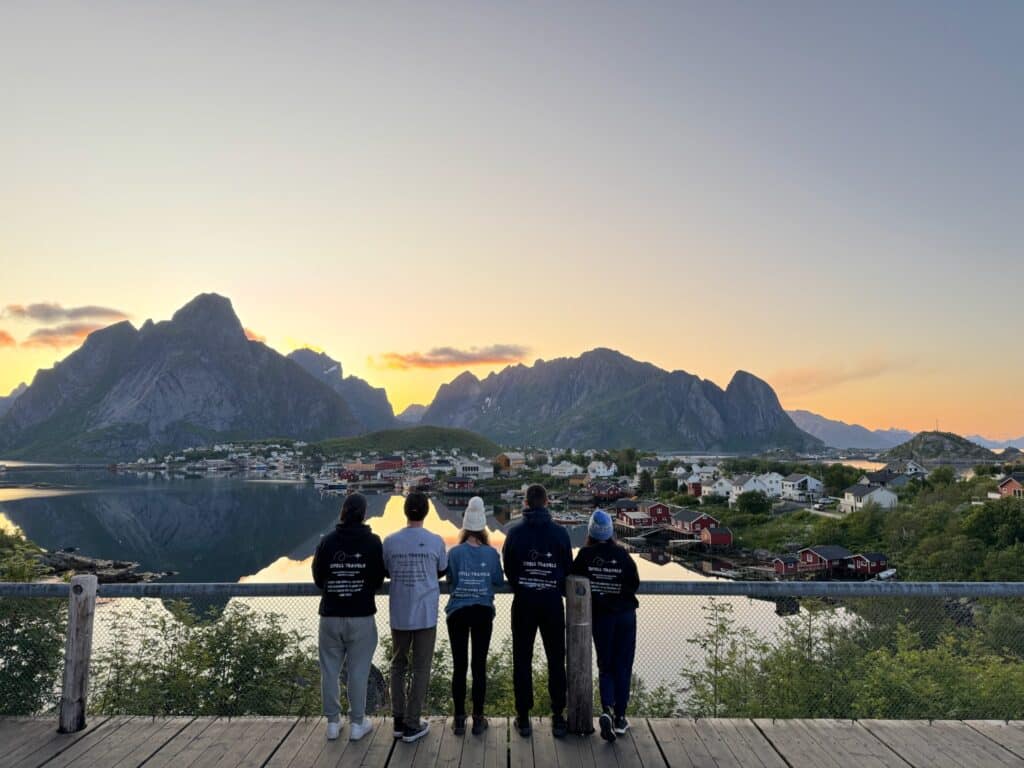Dylan and Maddy
9 Best Towns in the Lofoten Islands, Norway
Dreaming of wild mountains, colorful fishing cabins, and white-sand Arctic beaches? After spending nearly a week exploring the Lofoten Islands of Norway ourselves, we can honestly say this is one of the most jaw-dropping destinations we’ve ever visited. From dramatic fjords to tiny fishing villages, Lofoten’s unique towns are truly the heart of the experience.
In this guide, we’ll introduce you to the 9 Best Towns in the Lofoten Islands, each with its own personality, highlights, and must-see spots. Whether you’re road-tripping, hiking, or just soaking up the views, these towns are the perfect base for your Arctic adventure.
Why Visit Lofoten’s Towns?
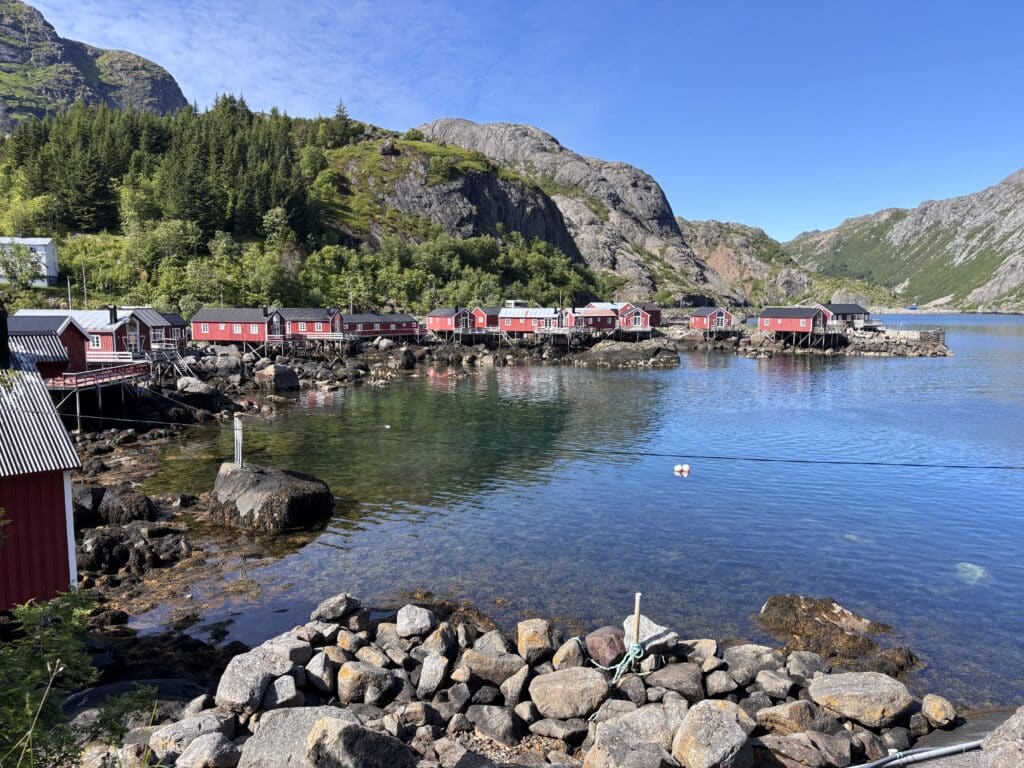
The Lofoten Islands are world-famous for their dramatic scenery, but it’s the towns and villages that create the region’s soul. Here’s why exploring them is a must:
- Authentic Norwegian Culture: Many Lofoten towns are working fishing communities, some with centuries-old traditions you can still experience today.
- Epic Photography: From the iconic red rorbuer cabins in Reine and Hamnøy to the colorful houses of Henningsvær, every town is a photographer’s dream.
- Adventure Basecamps: Each town offers easy access to hiking, kayaking, fishing trips, and more.
- Local Food: Sample fresh-caught cod, cinnamon buns, and Arctic char in cozy waterfront cafés and bakeries.
- History & Heritage: Many villages feel like living museums, with preserved architecture and fascinating local stories.
How Many Days Should You Spend in the Lofoten Islands?
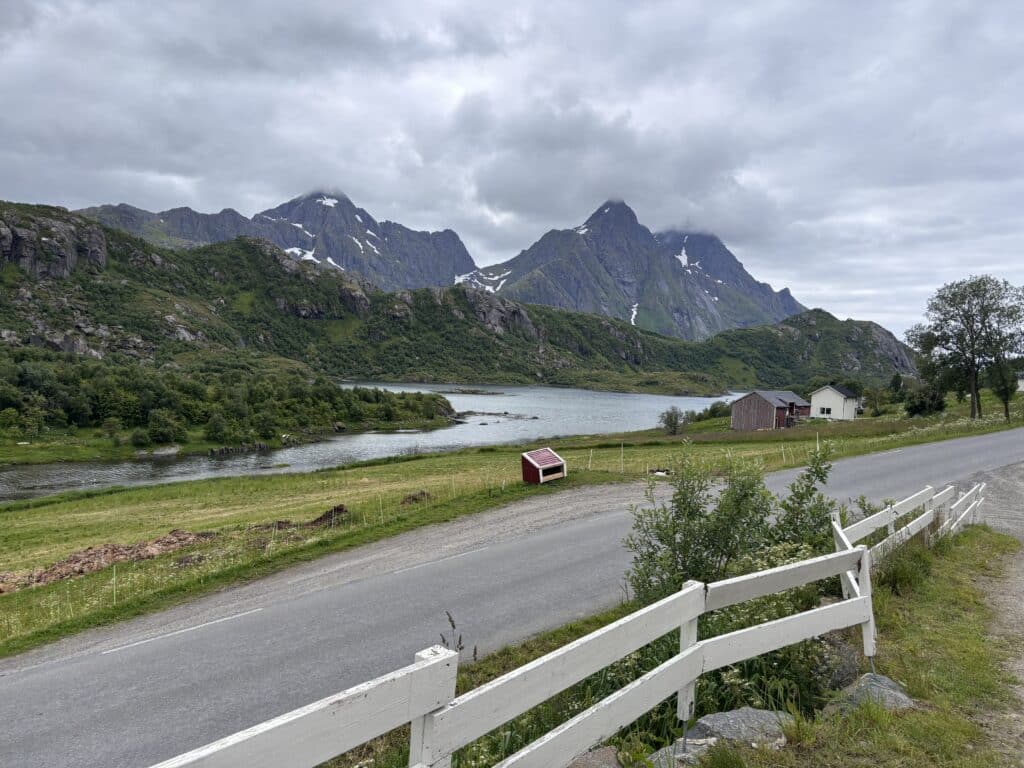
We spent almost a full week in Lofoten—and it was incredible. The original plan was to have a buffer for bad weather days, since Lofoten is known for being moody and unpredictable (seriously, it can go from sunny to sideways rain in 10 minutes). But somehow… we got seven straight days of good weather, which is basically unheard of.
As amazing as that was, we’ll admit: with seven nice-weather days, we had more downtime than we expected. We explored almost every major town, went on hikes, lounged by beaches (even if it was chilly), and still had hours to kill. So here’s our honest breakdown:
- 3–4 nice-weather days → doable but rushed. You’ll hit the highlights (Reine, Henningsvær, a beach or two, maybe a short hike), but you’ll feel like you’re always moving.
- 5 nice-weather days → the sweet spot. Enough time to slow down, see the best spots, get in some hiking and photo stops, and still have some flexibility.
- 7+ days → great if you want to relax or plan for 1–2 rainy days. This was our plan, and it worked out. If you’re coming from far away (which most people are), it makes sense to give yourself a buffer just in case the weather isn’t cooperating.
Pro tip: Don’t assume every day will be adventure-ready. Plan for weather delays, and don’t be afraid to have a chill day with a book or a long drive through scenic towns. That’s the Lofoten vibe too.
And don’t forget—getting to Lofoten isn’t super quick or easy, so if you’re making the trip, we recommend staying at least 5 days total to make it really worth it.
Best Towns in the Lofoten Islands, Norway
1. Reine
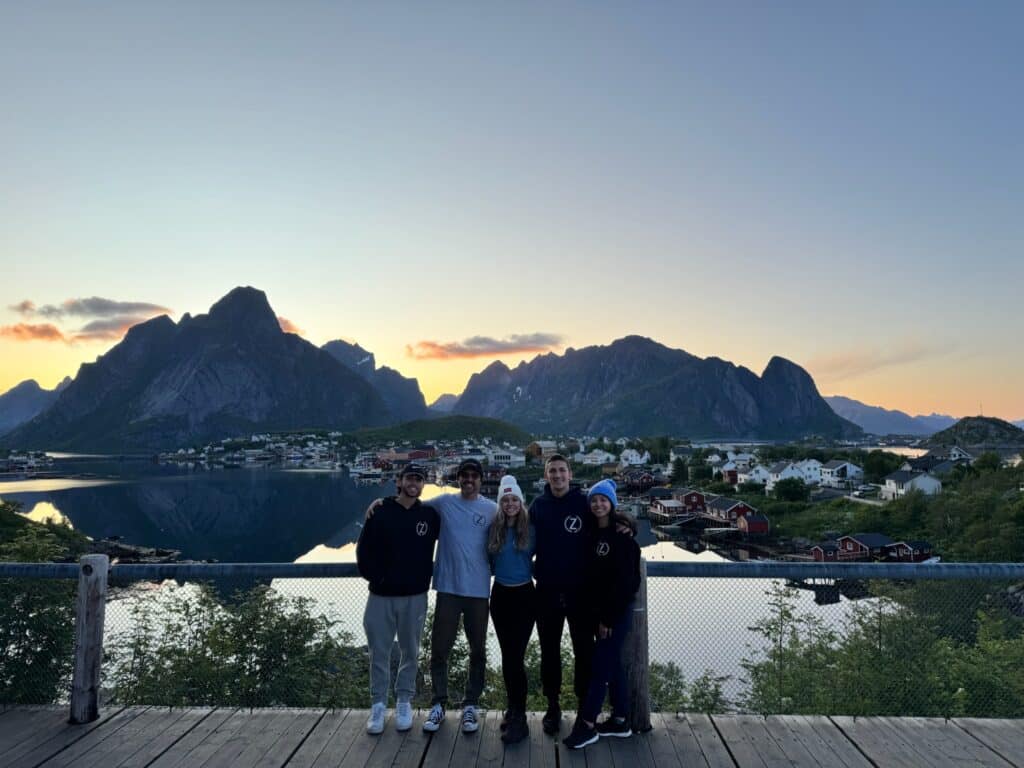
Why Visit:
Reine is the classic “Lofoten postcard”—red rorbuer cabins, turquoise waters, and jagged peaks in every direction. It’s small but absolutely iconic, and for many travelers, it’s the highlight of the islands. Reine sits in the western part of Lofoten, near the very end of the archipelago in the southwest.
Our Experience:
This is where we took on Reinebringen, probably the most famous hike in all of Lofoten. The trail climbs 1,978 stone steps, built by Nepali Sherpas, straight up the mountain. Our quads and hamstrings were feeling it big time, but overall, it’s not an insanely difficult hike. In fact, it used to be way sketchier before the steps were built—now it’s much safer and more accessible.
We did the hike during the midnight sun, and we highly recommend it. It’s such a unique and wild experience—like, how is it even possible that it’s still bright outside at midnight? We started the climb around 11 PM and reached the top just after midnight, with golden light still glowing across the landscape.
Maddy and a couple of others in our group had to push through some fear of heights, but we all made it to the top—and man, was it worth it. From the summit, you’re looking down at Reine and the surrounding fjords, with jagged peaks stretching in every direction. Honestly, it’s one of the top three views we’ve ever seen—breathtaking, surreal, and totally unforgettable.
It’s definitely a workout, but if you’re only doing one hike in Lofoten, make it this one. You won’t regret it.
Top Things to Do in Reine:
- Climb Reinebringen (come prepared—it’s no casual stroll!)
- Stay in a cozy rorbu cabin right on the water
- Join a guided kayak tour in the Reinefjord
Travel Tip:
The best time to visit Reine and hike Reinebringen is from late June to early September, when the trail is snow-free and the steps are safe to climb. Try to go early in the morning or late in the evening for the midnight sun!
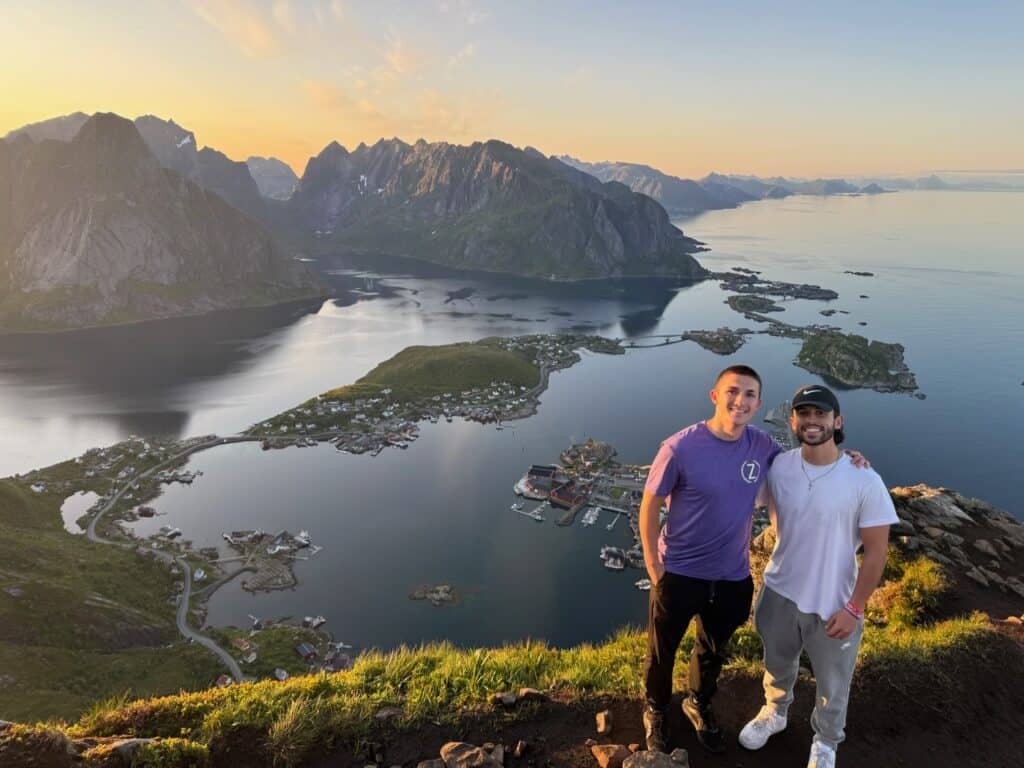
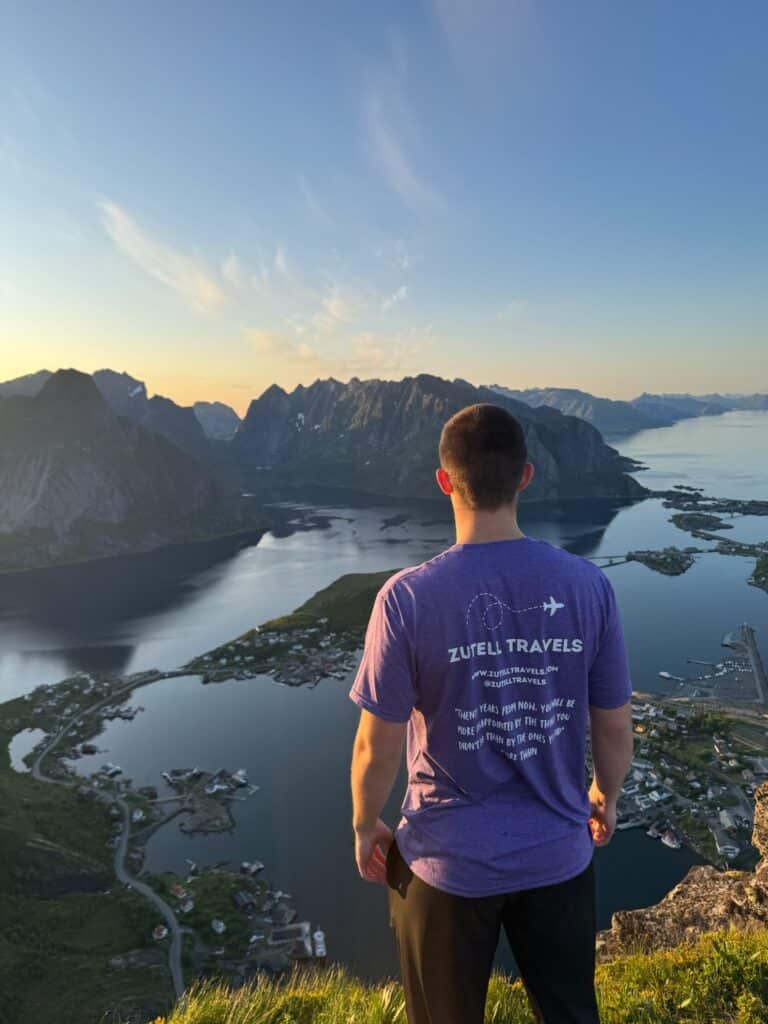
2. Henningsvær
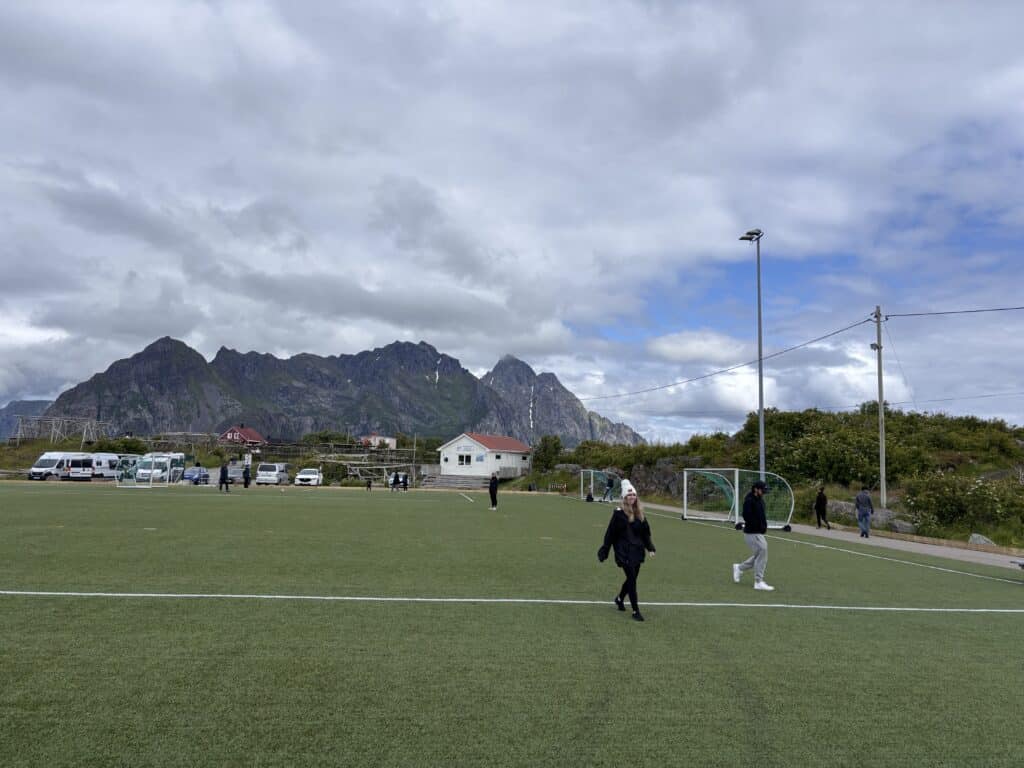
Why Visit:
Henningsvær is one of the coolest and quirkiest villages in Lofoten. It’s built across a series of tiny islands connected by bridges, giving it this fun, spread-out feel—kind of like a Norwegian Venice, but way more chill. With colorful harbors, cozy cafés, and sharp mountain peaks rising behind it, it’s easily one of the most photogenic spots in the islands. Oh, and yes—that famous football field is just as epic in real life.
Our Experience:
We headed straight for the Henningsvær Football Field, and honestly, it was such a blast. It’s open to the public, so we ran around, kicked a ball a bit, and just took in the views. There’s even a little playground next to it if you’re traveling with kids.
Afterward, we stopped by Henningsvær Lysstøperi and Cafe, which we’d definitely recommend. They had a ton of options, and everything we tried was super tasty. We’re gluten-free, so we grabbed a smoothie and a slice of really good gluten free apple cake.
We didn’t do any museums, but honestly, just walking around the village was enough. The whole place is beautiful and full of charm.
Top Things to Do:
- Visit the iconic Henningsvær Football Field (yes, you can run around on it!)
- Hike Festvågtind for a short, steep climb with insane views over Henningsvær
- Grab a bite at Henningsvær Lysstøperi and Cafe—great food and cozy vibes
- Wander the harbor and explore local shops
Travel Tip:
Festvågtind is best hiked in good weather and sturdy shoes—it’s short but gets steep fast. Go early or late in the day to avoid crowds and catch that golden glow over the village. If you’re not into hiking, just stroll the bridges and soak up the views—they’re unreal.
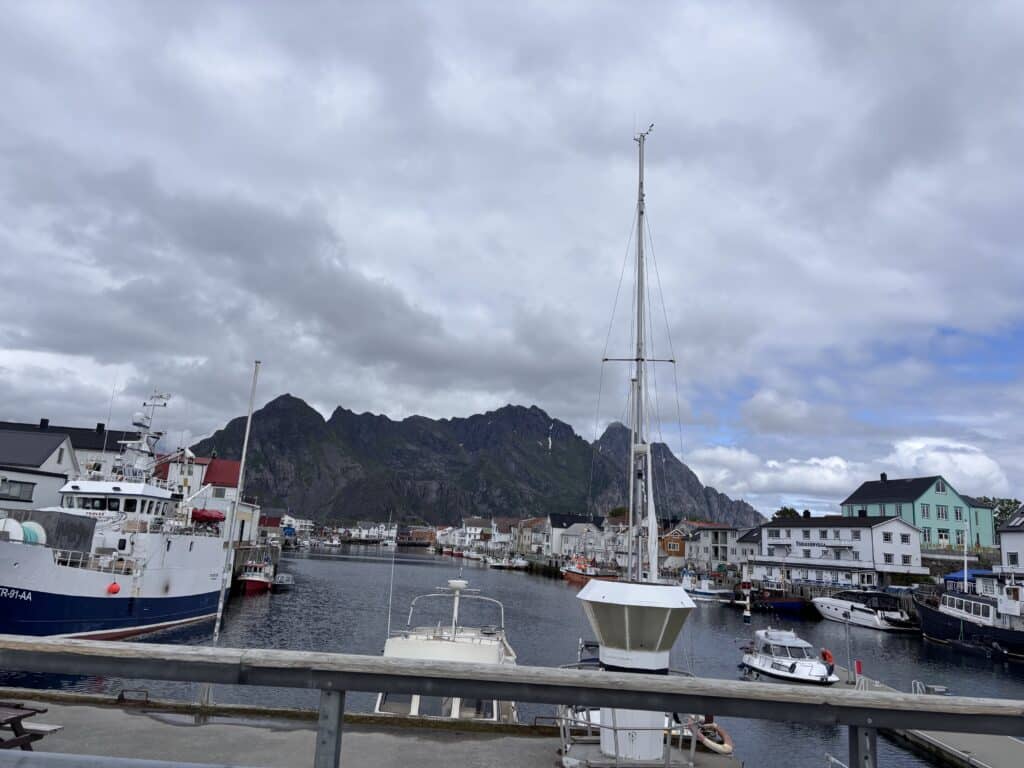
3. Leknes
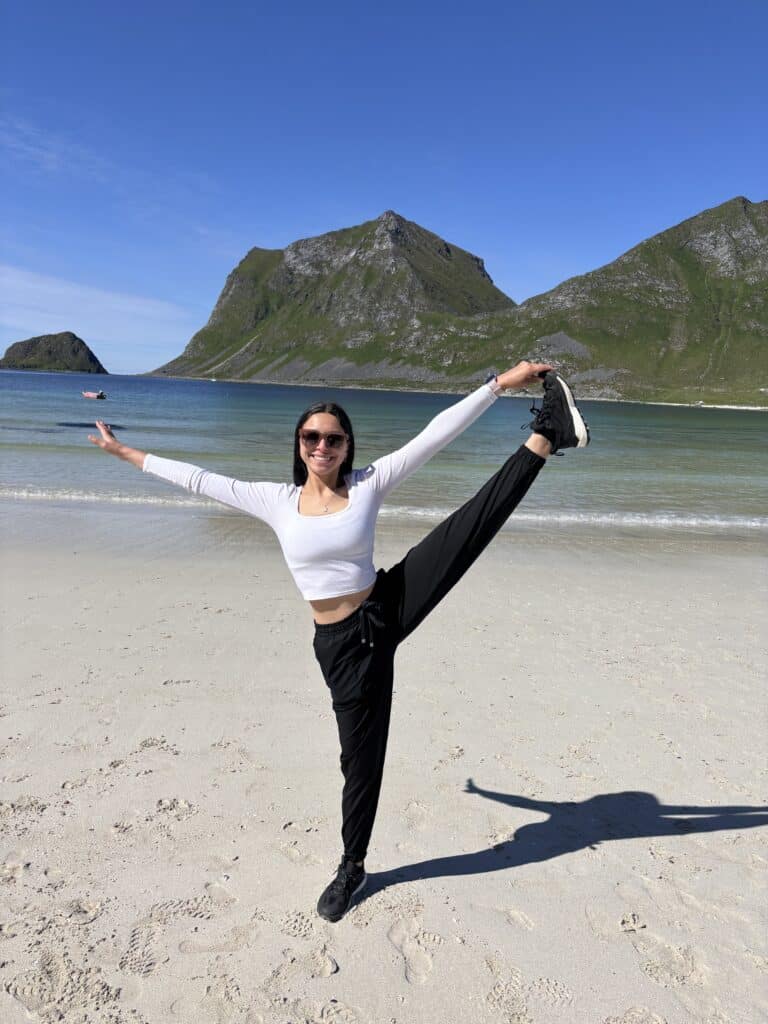
Why Visit:
Leknes isn’t the flashiest town in Lofoten, but it’s one of the most useful—and honestly, kind of underrated. It’s centrally located, making it the perfect home base for exploring both the western and eastern parts of the islands. Plus, it’s a bit more populated than other towns, so you’ll find actual grocery stores, gas stations, and restaurants that stay open past 6 PM (a win in Lofoten).
Our Experience:
We stayed in Leknes during our trip and were glad we did. It made day-tripping to places like Reine, Henningsvær, and Å super convenient. The town itself is cute and low-key, with local shops where you can pick up souvenirs, snacks, or anything you forgot to pack.
One of the best perks of being based here? You’re just minutes away from Haukland Beach and Vik Beach, two of the most beautiful stretches of sand in Lofoten. When the sun is out, the water turns this beautiful shade of blue, and the white sand seriously gives tropical beaches a run for their money. If only it was a little warmer—because even with perfect weather, the water’s still cold enough to make you question every life choice. Still, it’s a dreamy spot to relax, walk, or just sit and take it all in.
Top Things to Do:
- Visit Haukland Beach and Vik Beach
- Shop for souvenirs and local goods in town
- Grab groceries or fuel up before heading out on the road
- Use Leknes as a base to explore all corners of the islands
Travel Tip:
If you’re visiting Lofoten without switching accommodations every night, Leknes is a great base. It’s central, well-connected, and has everything you’ll need—especially helpful when smaller towns nearby don’t have services open late or at all.
4. Hofbräuhaus
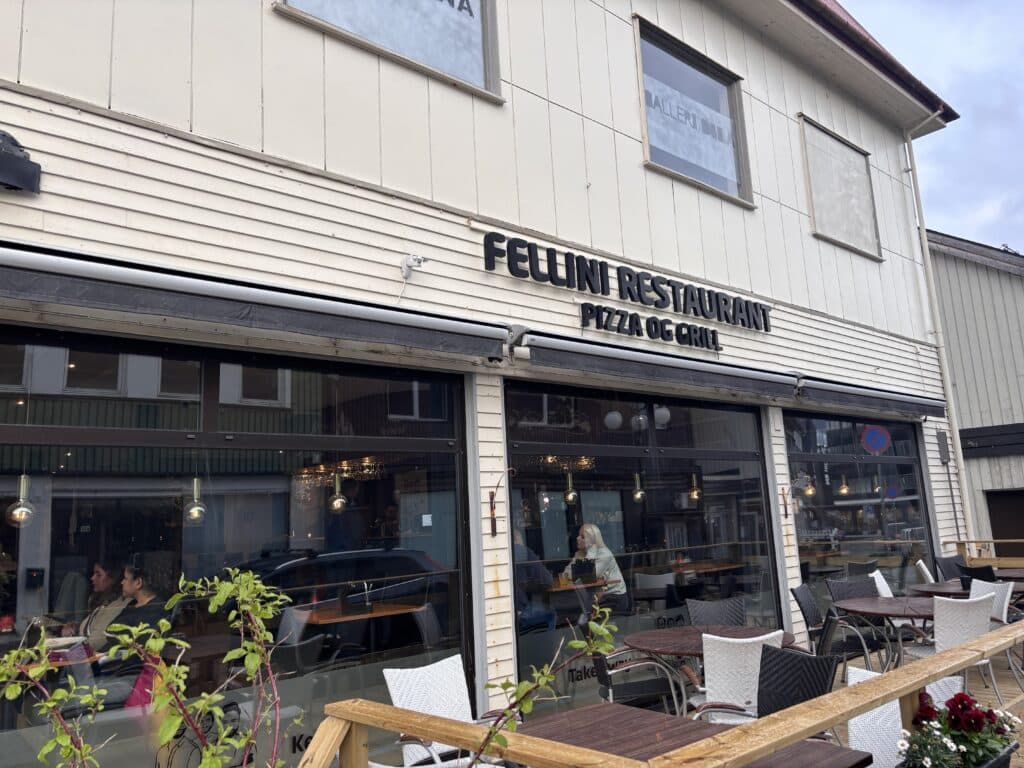
Why Visit:
Svolvær is the biggest town in the Lofoten Islands, and if you’re looking for a livelier base with more going on, this might be your spot. It has a working harbor, actual nightlife, and hosts several festivals throughout the year—so depending on when you visit, you might catch live music, art shows, or even a cod-themed celebration (it’s a thing).
It’s also one of the most accessible towns, with an airport and ferry connections, making it a common first stop for travelers arriving in Lofoten.
Our Experience:
We didn’t spend a ton of time in Svolvær, but we did walk around the harbor and check out some local shops before grabbing dinner at Fellini Lofoten. If you’re craving pizza, burgers, or steak, this place has it. The food was great, the vibes were casual, and the staff was super friendly – definitely recommend!
Compared to smaller villages like Reine or Henningsvær, Svolvær feels a little more like a real city—but that also means it’s a bit farther from the dramatic scenery of Lofoten’s southwest corner. It’s a good base if you’re focusing on the northern part of the islands or want a bit more convenience and infrastructure.
Top Things to Do:
- Explore the Svolvær harbor and waterfront shops
- Eat at Fellini Lofoten for a casual (and tasty) meal
- Catch a local festival if one lines up with your visit
- Take a sea eagle safari or boat tour around the surrounding fjords
Travel Tip:
If you want to be closer to Reine, Å, or the more remote parts of Lofoten, Svolvær might feel a bit out of the way. But for those flying in or traveling without a car, it’s one of the easiest and most comfortable places to stay.
5. Nusfjord
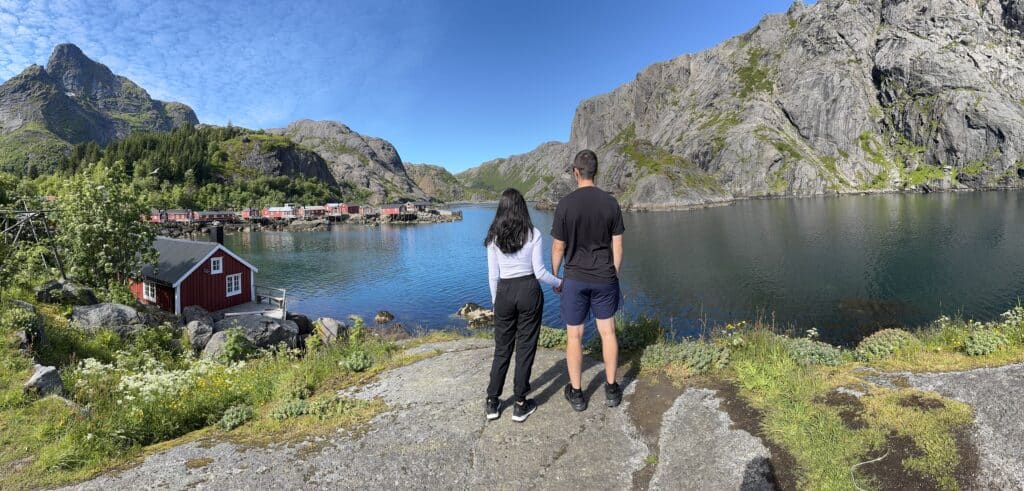
Why Visit:
Nusfjord is one of the oldest and best-preserved fishing villages in all of Lofoten—and is a UNESCO World Heritage Site! Nestled between dramatic cliffs and calm waters, it’s a quiet, scenic spot that looks like it was made for postcards. That’s probably because… it kind of was. Unlike other villages in Lofoten, Nusfjord isn’t a typical town where people live full-time. It’s more like an open-air museum with cozy cabins, a few shops, and some seriously beautiful views.
What’s extra unique is that you can actually stay overnight at the Nusfjord Arctic Resort, a charming spot that lets you sleep right in the heart of this historic village.
Our Experience:
We were surprised to learn that Nusfjord isn’t a traditional town—no grocery stores, no neighborhoods, no locals walking dogs. Instead, it’s more of a living museum, and honestly, we thought it was really cool. It’s peaceful, well-preserved, and super photogenic. You can stroll the wooden docks, peek inside historic buildings, and take in that classic rorbu-on-the-water vibe that Lofoten is famous for.
We had a lovely lunch at Karoline Restaurant, which sits right on the water and serves up local dishes with a view. Great food, great atmosphere, and plenty of spots nearby to snap a perfect photo after your meal. Nusfjord may be small, but it leaves a big impression.
Top Things to Do:
- Walk the historic fishing village and soak in the peaceful vibes
- Dine at Karoline Restaurant for fresh seafood and waterfront views
- Snap some of your best Lofoten photos (this place is made for it)
- Pop into the small shops and historic buildings around the harbor
- Enjoy the Spa or stay at the Nusfjord Arctic Resort.
Travel Tip:
Nusfjord feels more like a preserved village than a functioning town, and there’s a small entry fee to visit (since it operates like a museum). It’s worth it—but don’t expect gas stations or grocery stores here. Just come to wander, relax, and take in the beauty.
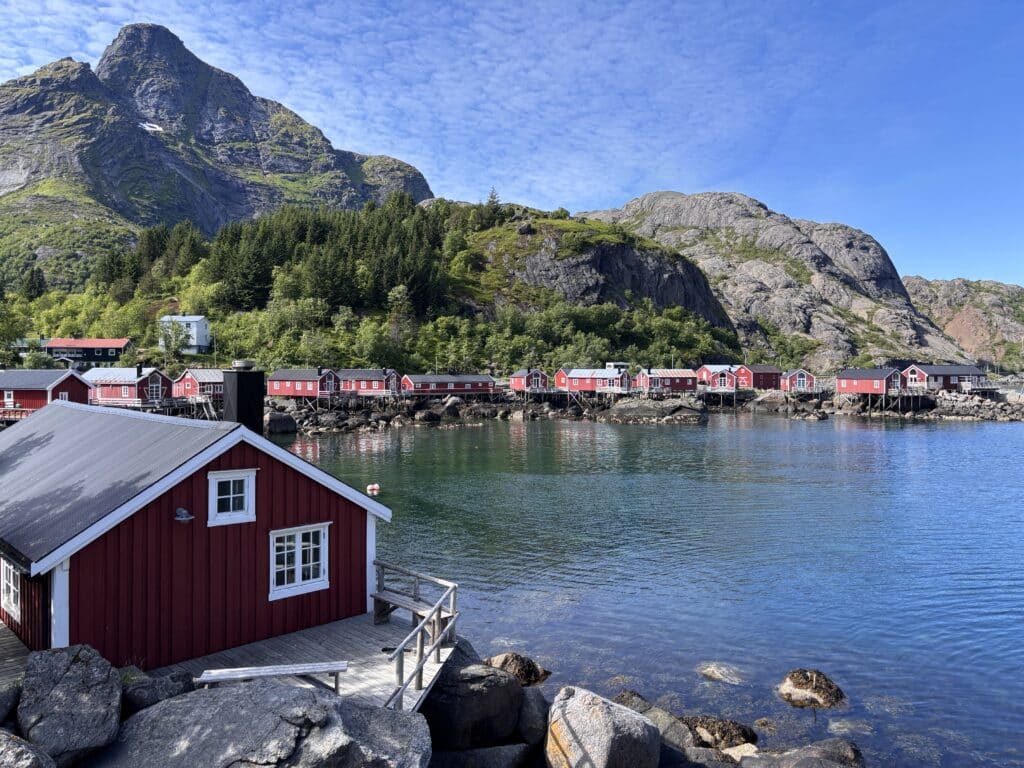
6. Å
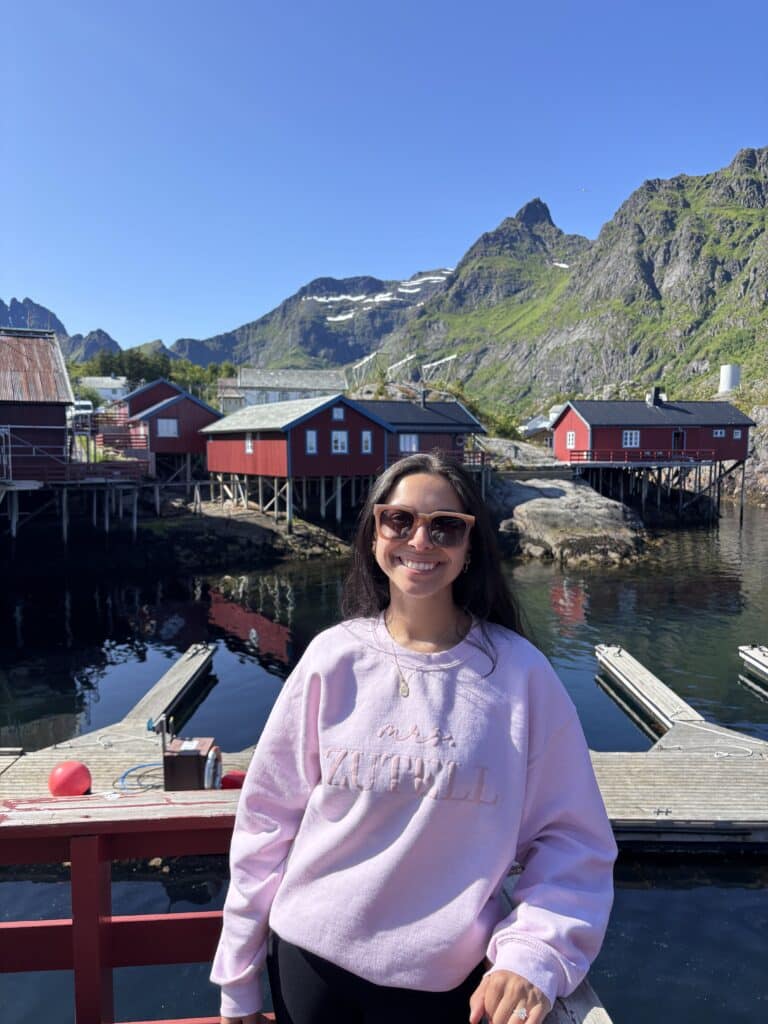
Why Visit:
Yes, the town is literally named Å, and yes—it’s just as charming as it is confusing on Google Maps. Located at the far southwest tip of the Lofoten Islands, Å is as “end of the road” as it gets. It’s peaceful, ridiculously beautiful, and home to a few small museums that highlight Lofoten’s fishing heritage. If you want dramatic coastal scenery and classic red rorbuer cabins stacked along the edge of the sea, this is the spot.
Our Experience:
Å was the furthest town from our base in Leknes (a little over an hour), but we’re really glad we made the drive. It’s quiet, scenic, and totally walkable—just one of those places that makes you stop and stare every few steps.
One highlight for us was the souvenir shop in town. Honestly, the Lofoten Islands aren’t the easiest place to find good souvenirs, but Å delivered. We found a cute shop with actually nice shirts, and the prices were way more reasonable than we expected.
We didn’t spend hours museum-hopping, but even just wandering around the town and along the water felt like an experience. It’s that postcard-perfect kind of peaceful.
Top Things to Do:
- Visit the Norwegian Fishing Village Museum and nearby historic buildings
- Shop for unique souvenirs and clothing at the local gift shop
- Walk around the village and take in the stunning coastal views
- Grab a snack and enjoy the relaxed end-of-the-world vibe
Travel Tip:
Å is located at the very end of the E10 highway, so if you’re based further north (like in Leknes or Svolvær), plan for extra drive time. It’s worth the trip—but best done on a day when you can slow down and enjoy the journey and the destination.
7. Hamnøy
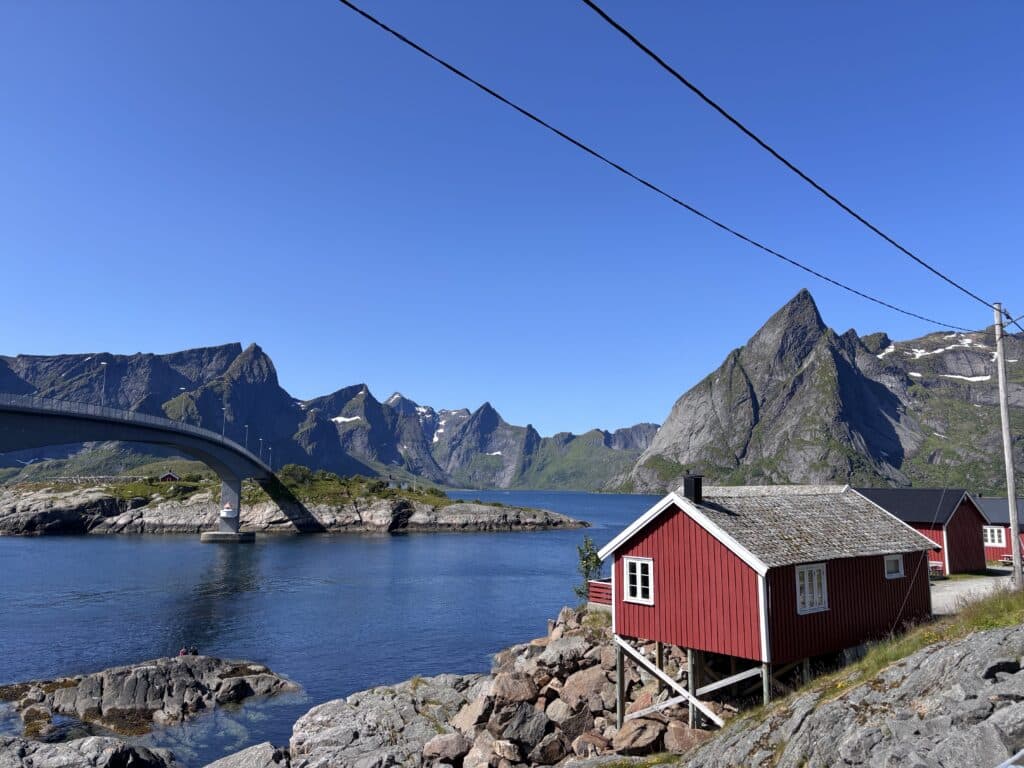
Why Visit:
Hamnøy is one of the most photographed little towns in all of Norway—and for good reason. Classic red rorbuer cabins over turquoise water, with jagged peaks rising behind them. Yes, it’s very beautiful! While there’s not much to “do” here activity-wise, the views alone make it worth a stop.
Our Experience:
We stopped in Hamnøy on our way to Reine (it’s only about 10 minutes away), and it was totally worth pulling over for. We walked around the little harbor, wandered the docks, and soaked in the peaceful vibe of this tiny village. It’s super small, but honestly, that’s part of the charm.
It’s not a place you spend hours exploring, but if you’re road-tripping through Lofoten, this is one of those “you just have to see it” stops.
Top Things to Do:
Take iconic photos of the red fishing cabins from the Hamnøy Bridge
Walk the docks and admire the coastal scenery
Breathe in that crisp sea air and enjoy the quiet
Travel Tip:
Don’t plan a full afternoon here—this is more of a quick scenic stop. Combine it with your visit to Reine or Sakrisøy and bring your camera!
8. Kabelvåg
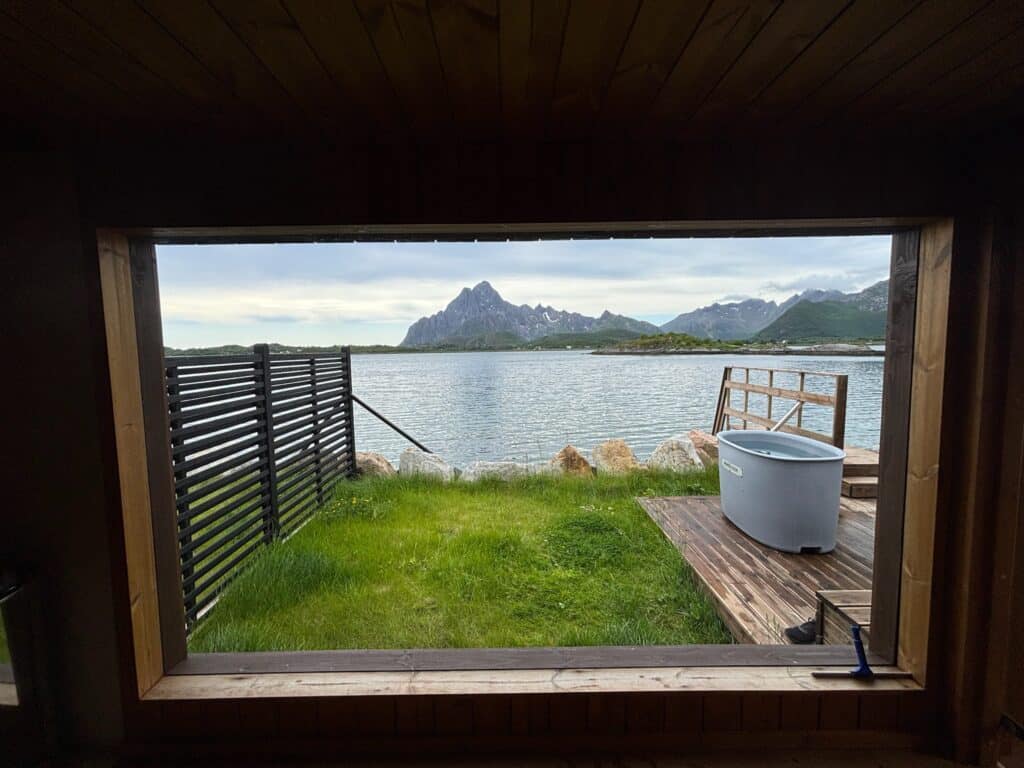
Why Visit:
Kabelvåg is a charming little town with a mix of history, relaxation, and low-key fun. It’s not as flashy as Reine or as bustling as Svolvær, but it’s a great place to slow down and enjoy some off-the-beaten-path experiences.
Our Experience:
We spent almost a full day here and really enjoyed it! First up was the Lofoten Aquarium—it’s definitely on the smaller side and not super flashy, but it was cute and a fun way to learn more about Arctic marine life. If you’ve got extra time in your itinerary, it’s a solid stop.
The real highlight for us, though, was Skarungen. We booked a private spa session there, which came with a hot tub, sauna, and absolutely insane views. It was peaceful, relaxing, and honestly just felt amazing to finally get into some sort of water—even if it was just a hot tub. Skarungen is more of a resort, but you don’t have to stay overnight to enjoy it. You can come for the spa, grab a bite at their restaurant, or even go kayaking.
We also visited the Vågan Church, and it gave total Transylvania vibes (in the coolest way). You can walk inside and look around, but the dramatic exterior is definitely the main event. So photogenic!
Top Things to Do:
- Visit the Lofoten Aquarium for a quick marine life fix
- Relax in the private spa at Skarungen
- Check out Vågan Church for its gothic-like exterior
- Kayak or dine at Skarungen for even more chill Lofoten vibes
Travel Tip:
Skarungen can book up, especially the private spa sessions—so reserve your spot in advance if you’re interested. It’s worth the splurge!
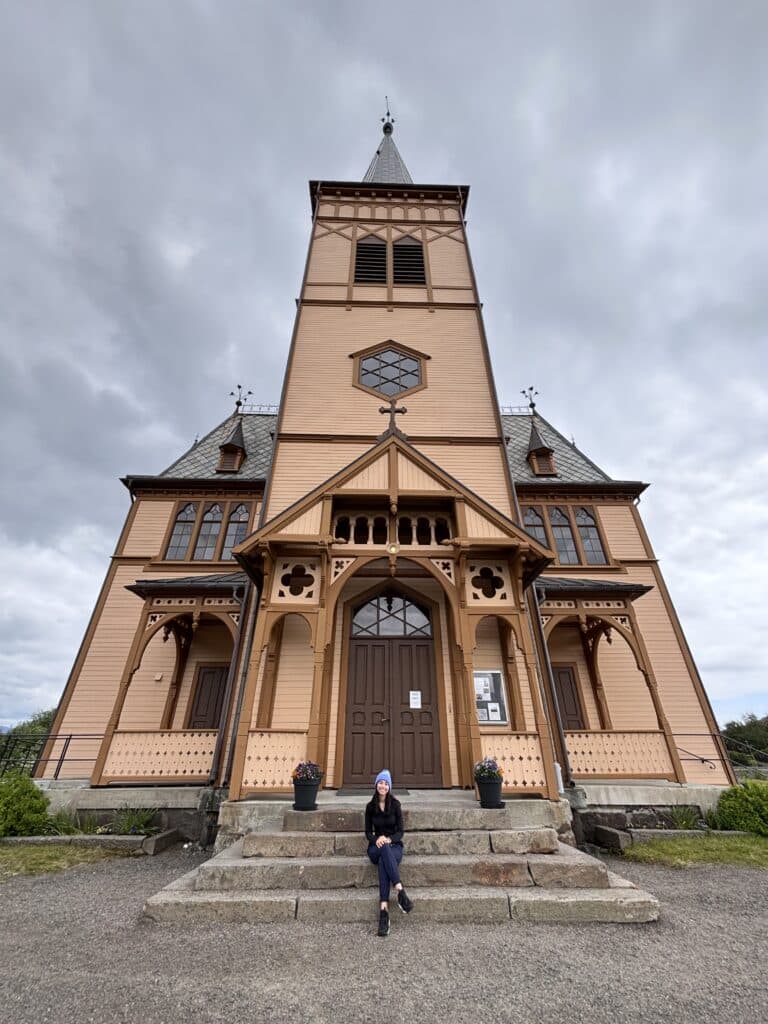
9. Ramberg
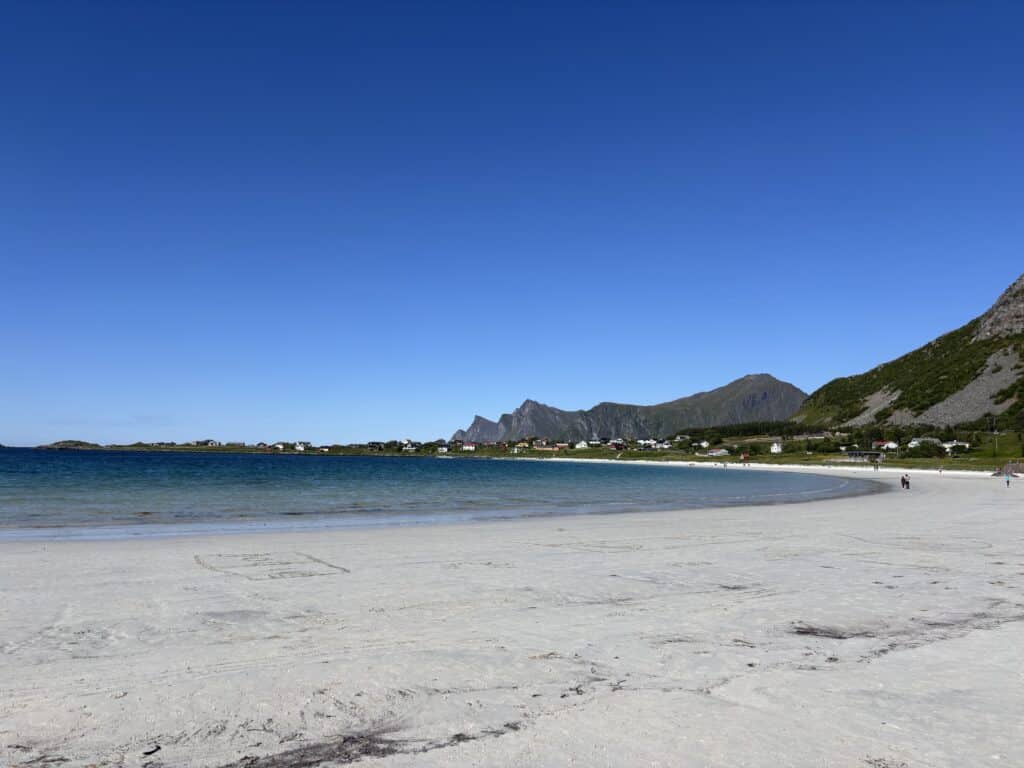
Why Visit:
Ramberg is a chill little village with a cozy vibe. It’s home to one of the most beautiful beaches in the Lofoten Islands, with soft white sand and turquoise waters that look like they belong way further south. Plus, there’s a small soccer field where you can kick around if you’re feeling sporty.
Our Experience:
We loved hanging out at Ramberg Beach—it honestly might be the most stunning beach we visited in all of Lofoten. The sand was so soft and the views were unreal. We just wish the water was warm enough to actually swim in! Even on a sunny day, Ramberg had a bit of a chilly breeze that reminded us we were definitely up north, but that didn’t stop us from soaking it all in. The fresh air and open space made it totally worth the visit.
Top Things to Do:
Play a casual game on the local soccer field
Relax or stroll along Ramberg Beach’s stunning white sand
Take in the rugged coastal views and feel that crisp sea breeze
Travel Tip:
Ramberg can be windy, even on clear days, so pack a light jacket just in case. But trust us, the views and beach vibes here make it more than worth it.
FAQ — Your Lofoten Travel Questions Answered
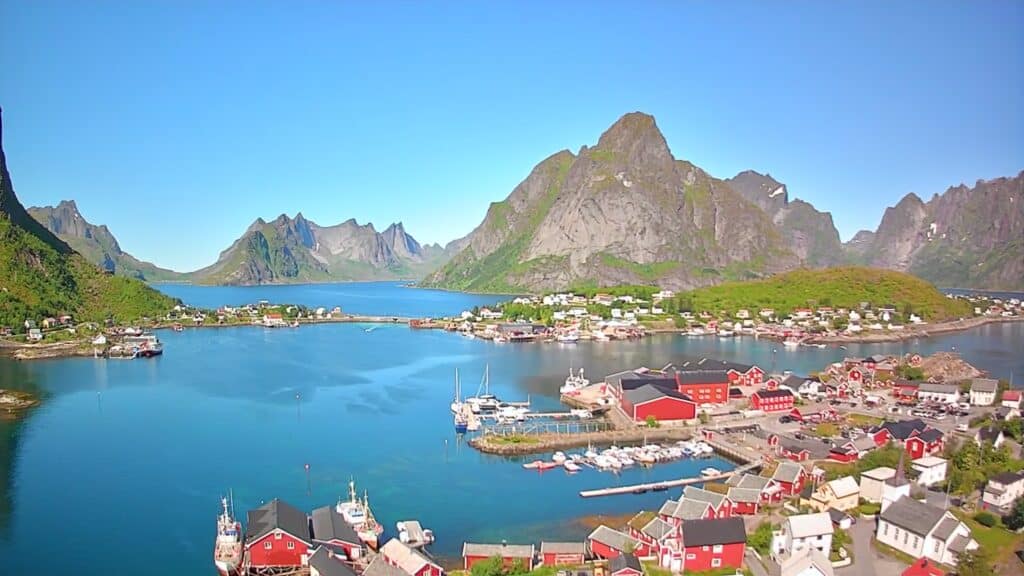
What’s the best time of year to visit Lofoten?
Late June to early September is prime time for good weather, long days (hello midnight sun!), and all hiking trails open. Winter is amazing for Northern Lights but much colder and with limited access to some roads and hikes. After driving in Lofoten, we would never want to visit in winter because the roads are so thin and windy.
How do I get around the Loftoen Islands?
Rent a car! It’s the easiest way to explore. Public transport is limited and won’t get you to most scenic spots easily.
Is it expensive to eat out in Lofoten?
Yes, eating out can be pricey and break your budget easily! We recommend booking accommodations with a kitchen so you can cook more of your meals.
Are the hiking trails safe for beginners?
Most are doable for beginners, but some, like Reinebringen, are steep and rocky. Bring good shoes, and don’t push yourself too hard. The views are worth it!
Do I need to book accommodation far in advance?
Definitely in summer. Lofoten is popular, and good / more affordable spots fill up quickly.
Can I fly a drone in the Lofoten Islands?
Yes, but there are rules. You’re allowed to fly drones in the Lofoten Islands, but you need to follow Norwegian aviation laws. That means no flying over crowds, keep your distance from wildlife, and always stay below 120 meters (about 400 feet). Some areas, especially around airports or protected nature zones, are completely off-limits.
Final Thoughts on our Week in the Lofoten Islands
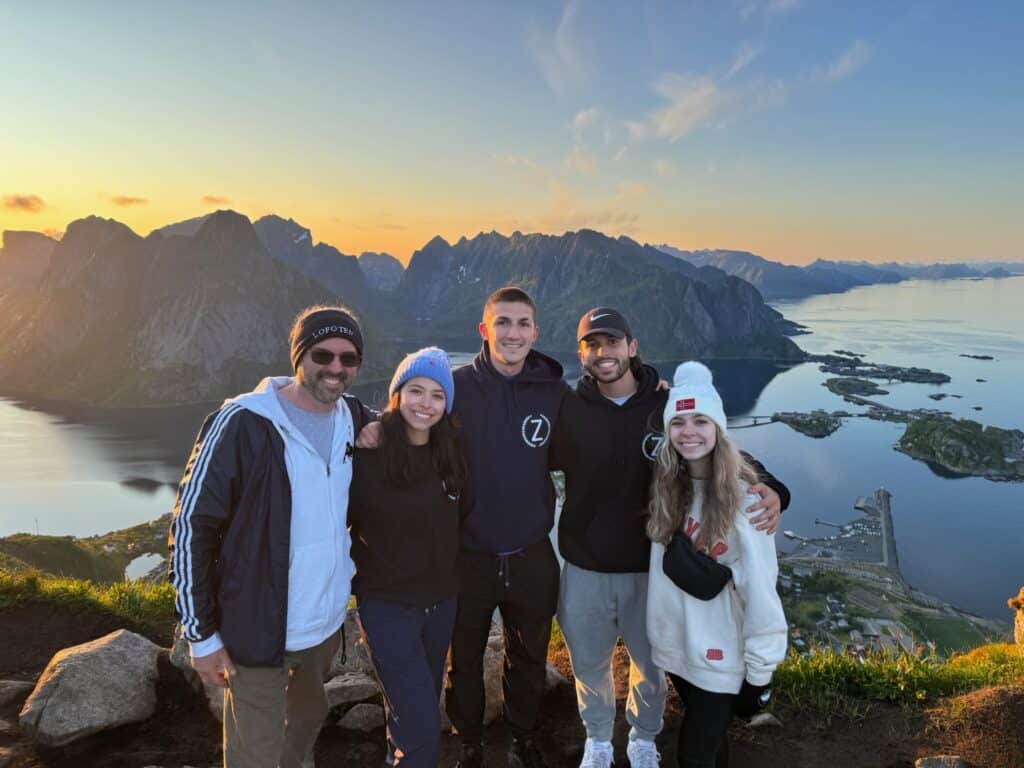
We absolutely loved our time in the Lofoten Islands—it was such a special trip. Between the jaw-dropping landscapes, peaceful villages, and the crisp Arctic air, it’s the kind of place that sticks with you long after you leave.
That said, we’ll be real: while the natural beauty is unmatched, there aren’t a ton of activities to do beyond hiking, exploring towns, and soaking up the scenery. But honestly, that slower pace is part of what makes Lofoten feel so magical. It’s not about checking off a million activities—it’s about slowing down and being fully present in one of the most beautiful corners of the world.
In no particular order, our top three most beautiful places we’ve ever visited are:
- The Jungfrau region of Switzerland (Grindelwald, Lauterbrunnen, Interlaken)
- The Amalfi Coast in Italy
- And now, the Lofoten Islands in Norway
Lofoten isn’t the easiest place to get to, but that’s exactly why it’s so special. If you’re down for a peaceful, scenic, unforgettable adventure—this is it. We highly recommend making the journey. Just pack for rain… and bring a nice camera. Trust us.
We hope this guide helps you plan an epic trip of your own! If you have any questions or want personalized tips, feel free to drop a comment or shoot us a message—we love helping fellow travelers.
Happy travels!
– Dylan + Maddy
More to explore

Weekend in Atlanta, Georgia: Best Things to Do
Discover the best things to do in Atlanta for a weekend trip, including attractions, sporting events, golf, transportation, and where to stay.

London vs. Edinburgh: Which UK City Should You Visit First?
Trying to decide between London and Edinburgh? We break down everything—from culture and attractions to food, prices, and vibes—to help you choose which iconic UK city is perfect for your next trip!
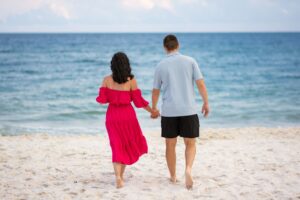
A Long Weekend in Gulf Shores, Alabama: Our Favorite Eats, Beaches, and Local Spots
Discover the best of Gulf Shores, Alabama—beaches, dolphin cruises, fun attractions, great eats, and travel tips for the perfect beach getaway.

